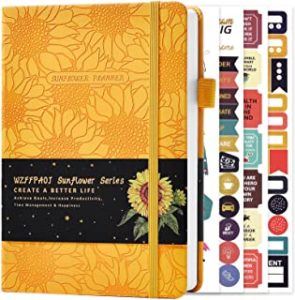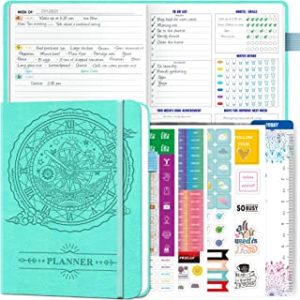Having a Language Learning Planner & Productivity Goal Planner when learning English can significantly enhance your language acquisition journey.
5 reasons to use a language learning planner
1. Organization and Structure: Language learning requires consistent effort and practice. A planner helps you organize your study sessions, set specific goals, and track your progress over time. With a structured plan in place, you're more likely to stay focused and motivated.

2. Goal Setting and Accountability: Setting clear language learning goals is essential for progress. A planner allows you to define specific objectives, such as improving vocabulary, mastering grammar rules, or enhancing speaking skills. By breaking down these goals into manageable tasks and setting deadlines, you hold yourself accountable for your learning.
3. Time Management: Learning a language requires investing time regularly. A planner helps you allocate dedicated time slots for language study and English courses amidst your busy schedule. By scheduling study sessions in advance and prioritizing language learning tasks, you can make the most of your available time and avoid procrastination.
4. Progress Tracking: It's crucial to monitor your progress to identify areas of improvement and celebrate milestones. A language learning planner enables you to record your daily or weekly achievements, such as completing exercises, learning new words, or practicing conversations. Tracking your progress not only boosts your confidence but also provides valuable insights into your learning journey.

5. Adaptability and Flexibility: Language learning is a dynamic process that requires flexibility to adapt to changing circumstances. A planner allows you to adjust your study plan based on your evolving needs, interests, and priorities. Whether you encounter difficulties with certain language skills or discover new learning resources, a planner helps you adapt your approach and stay on course toward your language learning goals.
Types of Language Learning Planner
Language learning planners come in various formats and designs to cater to different learning styles and preferences. Here are some common types of language learning planners:
1. Daily Planners: These planners are structured to help learners organize their language learning activities on a daily basis. They often include sections for setting daily goals, scheduling study sessions, tracking progress, and reflecting on learning experiences.
2. Weekly Planners: Weekly planners provide a broader overview of language learning activities for the entire week. They allow learners to plan their study schedule, allocate time for specific language skills or topics, and set weekly goals.
3. Monthly Planners: Monthly planners offer a more long-term perspective on language learning goals and progress. They typically include sections for setting monthly objectives, planning key milestones or events, and evaluating overall progress at the end of each month.
4. Goal-oriented Planners: These planners focus on helping learners set and achieve specific language learning goals. They may include sections for setting SMART (Specific, Measurable, Achievable, Relevant, Time-bound) goals, breaking down goals into actionable steps, and tracking progress towards goal attainment.
5. Progress Trackers: Progress trackers are designed to help learners monitor their language learning progress over time. They may include charts, graphs, or tables for recording various metrics such as vocabulary expansion, grammar mastery, speaking fluency, or proficiency levels.
6. Task-based Planners: Task-based planners are organized around completing specific language learning tasks or activities. They may include task lists, checklists, or to-do lists for completing exercises, practicing conversations, watching videos, reading texts, or engaging with language learning materials.
7. Skill-focused Planners: These planners are tailored to target specific language skills or areas of improvement, such as listening, speaking, reading, writing, grammar, vocabulary, or pronunciation. They may include exercises, drills, or activities designed to enhance proficiency in a particular skill area.
8. Digital Planners: Digital language learning planners are available in electronic or online formats, such as apps, websites, or software programs. They offer features such as customizable templates, automated reminders, interactive tools, and cloud synchronization for seamless access across devices.
9. Customizable Planners: Some language learning planners allow users to customize the layout, content, and design according to their individual preferences and needs. Users can add or remove sections, personalize goal settings, and tailor the planner to suit their unique learning journey.
10. Comprehensive Planners: Comprehensive language learning planners encompass multiple aspects of language acquisition, including vocabulary building, grammar practice, listening comprehension, speaking practice, cultural immersion, and exam preparation. They provide a holistic approach to language learning and cover all essential components of language proficiency development.
Whether you prefer a traditional paper planner or a digital tool, choosing the right type of language learning planner can help you stay organized, motivated, and focused on achieving your language learning goals. By providing structure, accountability, and flexibility, it empowers you to make steady progress and achieve proficiency in English more effectively.
You must be logged in to post a comment.